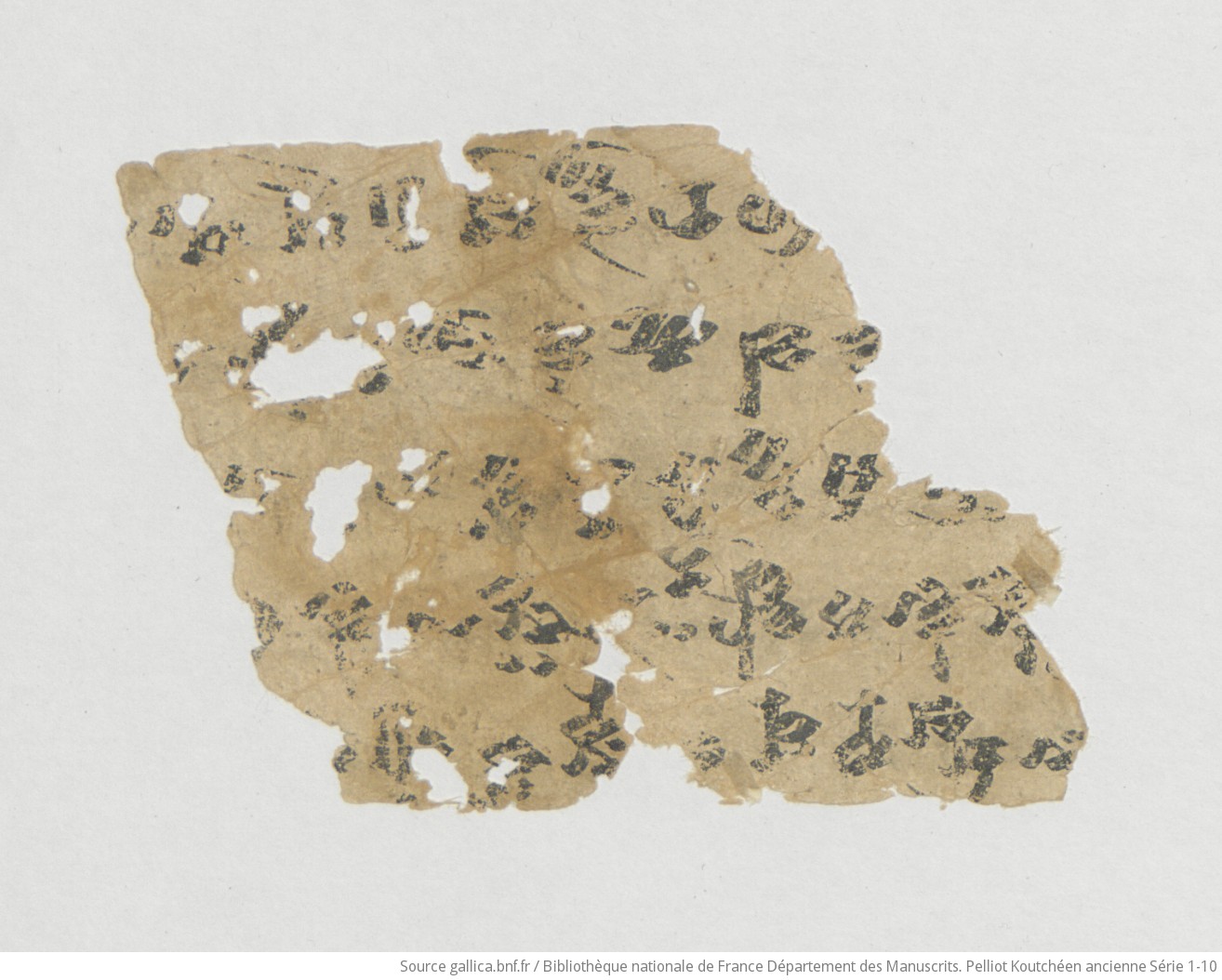Work in progress
PK AS 6J
| Known as: | PK AS 6J; Pelliot Koutchéen Ancienne Série 6J |
|---|
| Cite this page as: | Georges-Jean Pinault; Melanie Malzahn (collaborator); Michaël Peyrot (collaborator). "PK AS 6J". In A Comprehensive Edition of Tocharian Manuscripts (CEToM). Created and maintained by Melanie Malzahn, Martin Braun, Hannes A. Fellner, and Bernhard Koller. https://cetom.univie.ac.at/?m-pkas6j (accessed 13 Jul. 2025). |
|---|
Edition |
| Editor: | Georges-Jean Pinault; Melanie Malzahn (collaborator); Michaël Peyrot (collaborator) |
|---|
| Date of online publication: | 2012-02 |
|---|
Provenience |
| Main find spot: | Unknown |
|---|
| Collection: | Bibliothèque nationale de France, fonds Pelliot Koutchéen (Paris) |
|---|
Language and Script |
| Language: | Skt.; TB |
|---|
| Linguistic stage: | classical |
|---|
| Script: | classical |
|---|
Text contents |
| Title of the work: | Udānālaṅkāra |
|---|
| Text genre: | Literary |
|---|
| Text subgenre: | Doctrine |
|---|
| Verse/Prose: | verse |
|---|
Object |
| Material: |
ink
on paper |
|---|
| Form: | Poṭhī |
|---|
| Size (h × w): | 7.5 × 7.2 cm |
|---|
| Number of lines: | 5 |
|---|
| Interline spacing: | 1.5 cm |
|---|
Images
Transliteration
| a1 | /// sa ṣmā ka a m(·) sk(·) n[au] my[e] [n] /// |
|---|
| a2 | /// snai tse ta llā¯ ¯u (–) ¯stä ya ts[i] – /// |
|---|
| a3 | /// [m]āṃ śā nti ni rvṛ tiṃ [so] (–) ga /// |
|---|
| a4 | /// [ja] la bhū jaṃ ṅga ·i· vā ga /// |
|---|
| a5 | /// (–) hā rā jñā ā rya pū ṣpe /// |
|---|
| b1 | /// (–) pa sti śä lmo¯ ¯ñä śwā lyi : /// |
|---|
| b2 | /// (–) mṣä lle ta llā wno lme ya /// |
|---|
| b3 | /// ra [p](·) yśi ntse a kla s̝a lye (·)saṃ – /// |
|---|
| b4 | /// o¯ ¯t ma ske ta¯ ¯r• : pra tyai ka ra /// |
|---|
| b5 | /// : pra tyai ka ra [p](·) [dñ]ä k[t]e [u] (·)[i] /// |
|---|
Transcription
| * | (para)māṃ śānti nirvṛtiṃ so (dhi)ga(cchati) |
|---|
| * | ja la bhūjaṃṅga ·i·vā ··ga° /// |
|---|
| a5 | n3 /// (ma)hārājñā āryapūṣpe(na) |
|---|
Translation
| a1 | ... and because of ... much difficult ... the jewels ... |
|---|
| a2 | ... poor [and] miserable ... to go away... |
|---|
| a3 | Sanskrit |
|---|
| a4 | Sanskrit |
|---|
| a5 | Sanskrit |
|---|
| b1 | ... (they) are able ... (they) can be eaten. ... |
|---|
| b2 | ... (something is) to be (do)ne, the miserable being ... |
|---|
| b3 | ... the pupil of the omniscient (= Buddha) ... |
|---|
| b4 | ... then he becomes ... . Like a Pratyeka(buddha) ... |
|---|
| b5 | ... Like a Pratyekabuddha ... |
|---|
Commentary
Parallel texts
Philological commentary
| * | Recto and verso cannot be determined. There may be a meter with a cola of seven syllables in b1 ff. |
|---|
| n1 | Here we have a quotation of Uv 30.11cd without direct translation. It is possible that the two preceding pādas were also quoted before. |
|---|
| n2 | The Sanskrit is corrupt. One may venture to recognize jala-bhujaga- ‘watersnake’. This word is recorded as variant of Skt. uraga- ‘snake’ in a pāda repeated often in the Udānavarga (18.21d; 32.55-80). |
|---|
| n3 | This may be part of a colophon composed in Sanskrit referring to a Kuchean king bearing the Sanskrit name Āryapūṣpa. |
|---|
| n5 | tallā= wnolme stands for tallāw wnolme with sandhi (for tallāu onolme). |
|---|
Remarks
Linguistic commentary
| n4 | If read correctly, śälmoñ would be a nominative plural form of a masculine noun because of śwālyi. In that case this form seems to have mixed the inflection of the stems of class VI.2 (type pyapyo, pyapyaiñ), which show accent shift, with the inflection of the adjective and agent nouns in -mo, which have a nom.pl. in -oñ. It cannot be an agent noun of the type aiśamo, verse form aiśmo, since in this case one would expect †ślamo, †śalmo. |
|---|
| n6 | In both instances one can recognize a well-known Sanskrit compound pratyeka-buddha- lit. ‘Buddha for himself alone’ (cf. Edgerton 1953: 329a), a term which is frequent in Mahāyāna texts. This term has been transposed by simply replacing Skt. buddha- by its TB match, while using a hypercorrect form pratyaika with ‹ai› instead of ‹e›. |
|---|
Bibliography
Bernhard 1965
Bernhard, Franz. 1965. Udānavarga. Band I, Einleitung, Beschreibung der Handschriften, Textausgabe, Bibliographie. Sanskrittexte aus den Turfanfunden 10. Göttingen: Vandenhoeck und Ruprecht.
Edgerton 1953
Edgerton, Franklin. 1953. Buddhist Hybrid Sanskrit grammar and dictionary. New Haven: Yale University Press.




